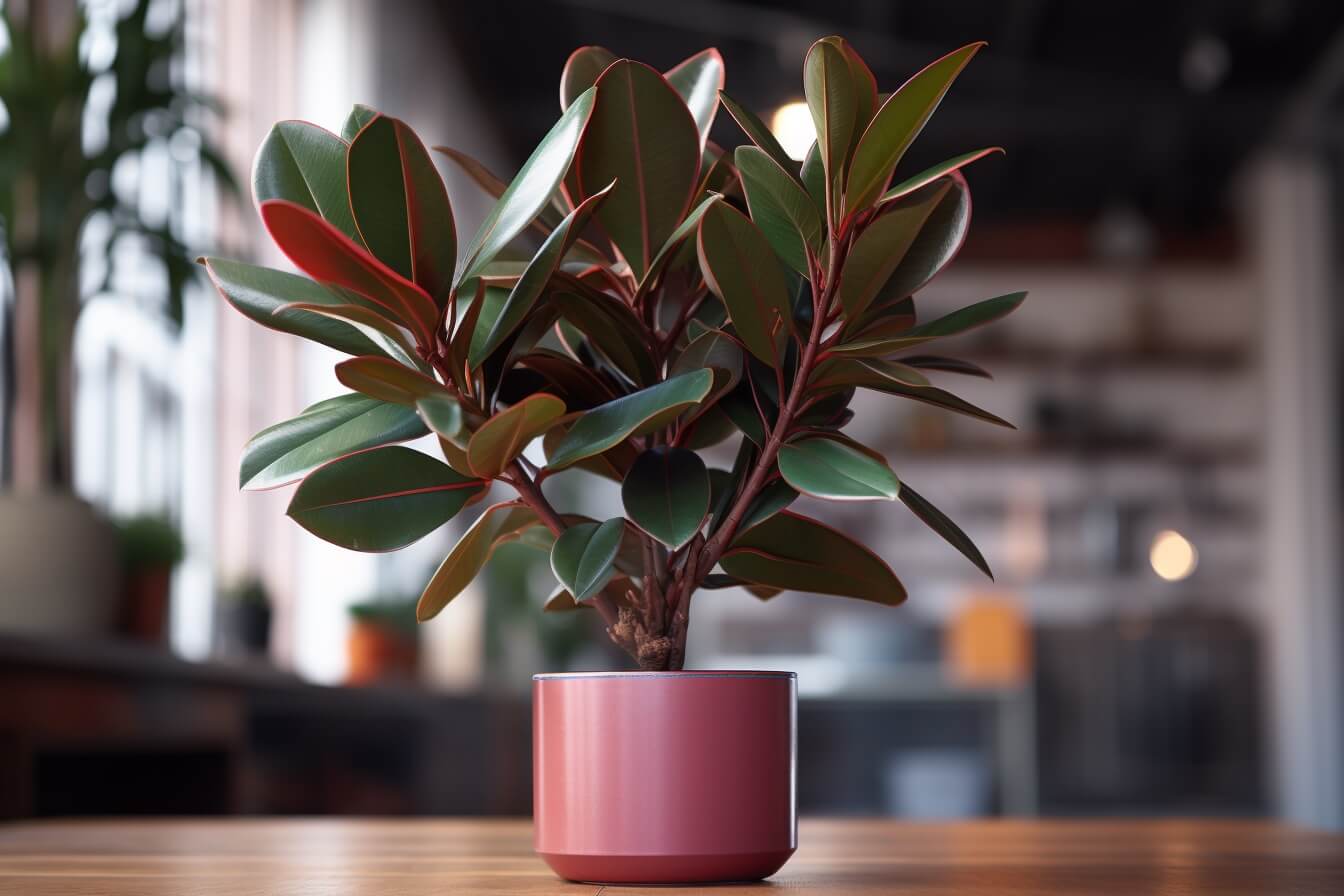Botanical Name: Ficus elastica “Ruby”
Nicknames: Ruby Rubber Tree, Pink Rubber Tree, Rubber Plant, Rubber Fig, Rubber Bush, Indian Rubber Tree
The Ruby Rubber Tree is a full plant that has large, almond-shaped leaves that are variegated with shades of strawberry pink, green, and cream. It is the perfect plant for a bright spot in your home. It is a strong and sturdy tree that can be used as a decorative plant or accent to your space. While it can reach heights of almost 40′ in its natural habitat, it typically will not get much larger than 8′ tall in your home. The large leaves convert carbon dioxide into oxygen, absorb harmful air pollutants, and eliminate mold spores and bacteria in the air.

Basking in Light: The Ruby Rubber Tree’s Illuminated Preference
The Ruby Rubber Tree is quite the sun-lover, but it prefers its light like a gentle morning embrace rather than a midday scorch. Bright, indirect light is its best friend. I’ve placed mine near a window with sheer curtains to filter the direct sunlight, which keeps its leaves from getting scorched.
Tip: Rotate your plant regularly to ensure even growth and prevent it from leaning towards the light source.
Quenching Thirst: Watering Your Ruby Rubber Tree
Watering this plant is like playing a game of patience and precision. It prefers its soil to be allowed to dry out slightly between waterings. I usually check the top inch of the soil; if it’s dry, it’s time for a drink. During the winter months, I reduce the watering frequency as the plant’s growth slows down.
Caution: Overwatering can lead to root rot, so better to err on the side of less water than too much.
Creating the Ideal Environment: Temperature and Humidity
The Ruby Rubber Tree enjoys a warm and stable environment, with temperatures around 60°F to 75°F (15°C to 24°C). It’s not a fan of cold drafts or sudden temperature changes, so I keep it away from open windows and air conditioning vents. As for humidity, it’s pretty adaptable but enjoys a bit of extra moisture in the air. A room humidifier or a pebble tray with water can do wonders.
Fun Fact: While it tolerates lower humidity, higher levels can encourage larger leaf growth.
Witnessing Growth: The Maturing of Your Ruby Rubber Tree
One of the joys of owning a Ruby Rubber Tree is watching it grow and mature. It’s a relatively fast grower, and with the right conditions, it can reach up to 10 feet indoors! Its beautiful ruby and green leaves keep getting larger as the plant grows.
Growth Alert: If your plant is getting leggy, it might not be receiving enough light.
Repotting Rituals: Giving Your Plant Room to Flourish
Every couple of years, your Ruby Rubber Tree will likely need repotting as it outgrows its current home. Choose a pot that’s only slightly larger than the previous one to avoid overwhelming your plant. The best time for repotting is in the spring, just as the growing season begins.
Tip: Use a well-draining potting mix to ensure your plant’s roots are happy and healthy.
Propagation Adventures: Multiplying Your Ruby Rubber Tree
Propagating this plant can be a fun and rewarding experience. The most effective method is air layering, though it requires some patience. You can also try stem cuttings, placing them in water until they root before potting them in soil.
Patience is Key: Remember, propagation takes time, so don’t rush the process.
A Note on Safety: Pet-Friendly Practices
It’s important to note that the Ruby Rubber Tree is toxic to cats and dogs if ingested. I always ensure my plants are out of reach of my furry friends to keep them safe and healthy.
Pet Owner Alert: Watch for signs of distress if your pet is prone to nibbling on plants.
Embracing Your Ruby Rubber Tree Journey
Caring for a Ruby Rubber Tree is a delightful experience that brings a touch of exotic beauty to your indoor space. Each aspect, from light to propagation, is a step in a journey filled with lush growth and vibrant color. Remember, every plant has its unique personality, and part of the fun is learning and growing alongside your leafy companion.
Happy Plant Parenting! 🌱💖🌞

